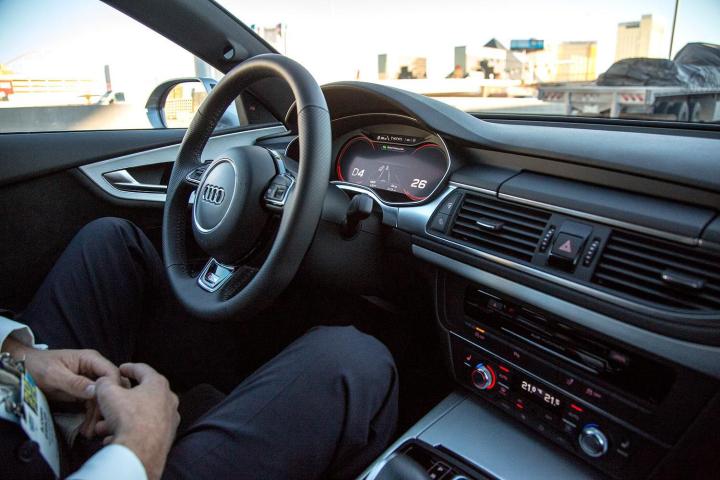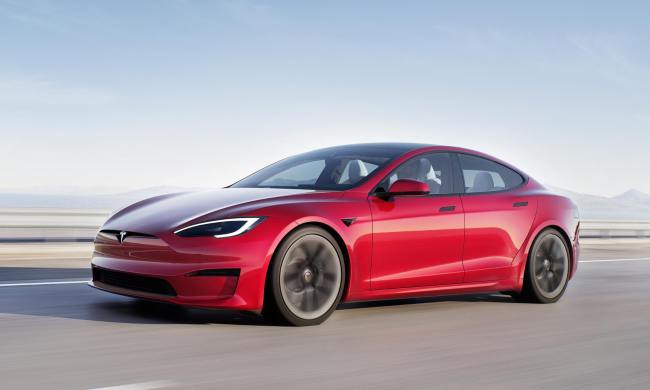
Carmakers tell us, however, that the arrival of autonomous, self-driving cars depends on the ability to use sensors already in place on some production cars. These sensors, including radar, and dual forward-facing cameras, currently used for accident mitigation and avoidance along with Adaptive Cruise Control (ACC), are intended to be used as the robot driver’s eyes.
Why must automakers give double duty to the sensors adorning the front-end of their latest models? That’s because the Velodyne Lidar Inc. unit atop self-driving cars like Google’s cost $70,000 apiece, which makes that technology financially unrealistic. And there is – rightfully – the expectation that few customers want cars with a metal cylinder on a mast on the roof, as the device requires.
Real life illustrates how far Distronic is from functioning as well as a beginning driver’s ed student.
However, that AI is going to need to be a lot smarter than it is today. To prove that point, let’s take a look at the autonomous driving dynamics and characteristics of the Mercedes-Benz S550, perhaps the most autonomous – and technologically advanced – car on American roads today, on a busy highway during stop-and-go rush hour traffic
The Mercedes-Benz Distronic ACC system illustrates the shortcomings of even the best technology today. The forward radar system watches the car ahead to keep a safe distance while the computer automatically applies throttle and brake as needed.
In some traffic situations, Distronic helps take the hassle of the monotonous gas, brake, gas dance from the driver, as the S550 automatically follows the car ahead. But in the swirling mayhem of multilane rush-hour urban traffic real life illustrates how far Distronic is from functioning as well as a beginning driver’s ed student.
When a compression wave of stoppage passes along a highway, drivers can see this in the form of a chain reaction of brake lights coming toward them. We human drivers reflexively react by lifting off the gas in anticipation of the car ahead braking as it reaches the stoppage.
But Distronic doesn’t. It can’t incorporate or analyze video input from its forward-looking visible light and infrared cameras. It doesn’t see those brake lights and the radar’s narrow beam can’t see around the car immediately ahead, so it also can’t see the stopping cars up the road.
A typical automotive radar system today has a maximum viewing angle of about 60 degrees, according to Doug Patton, senior vice president of the engineering division for Denso International America, Inc. “If you can increase the viewing angle, the ideal sensor would be 180 degrees and you’d put three on your car and see everything,” he explained. “That is not cost effective right now.”
The result in today’s S550 is the unsettling feeling of watching your car hurtle toward stopped traffic, oblivious to the need to slow until the car immediately in front brakes significantly. Instead of a calm, smooth stop, the car makes a nerve-rattling near-emergency stop because its computer was surprised by this sudden stop on the highway. That will keep drivers awake!
The Mercedes has cameras that could identify what traffic ahead is doing, but it isn’t currently using them to identify brake lights and anticipate what their appearance likely means for the speed of cars ahead. This is a huge shortcoming of current semi-autonomous cars and a big hurdle automakers will need to overcome before full automation is achieved.
Vehicles aren’t yet smart enough to make sense of brake lights, turn signals, and the movements of cars ahead of the one directly in front.
Not Distronic. It waits for the car ahead to pull away to a safe distance, only starting to move when the car ahead has built up a bit of speed, so the already-big-enough gap grows into a yawning space that the laws of traffic flow dictate cannot exist. Soon enough, an impatient driver will throw his or her car from an adjoining lane into the open space ahead of the S550, sometimes even signaling their intent to do so.
As the incoming car is merging from a stopped lane, they are doing so at a steep angle and low speed, just as the S550 is gaining enthusiasm about closing the gap to the car ahead. Distronic doesn’t see the turn signal and its narrow radar beam blazing down the center of the lane doesn’t see the merging car until it breaks that beam.
At this point it seems the Mercedes might ram the incoming car in the door, but it finally recognizes the incursion into the lane and slams on the brakes, long after a human driver would have eased off the gas to permit the merger. Yikes!
Same thing when passing an on-ramp. Wan to merge ahead of a Distronic-controlled S550? Forget it. Not going to happen, unless the human driver intervenes with a touch of the brake pedal to deactivate the system.
None of this is meant as a criticism of Distronic or the S550, only to illustrate that automakers aren’t utilizing the computers already onboard their vehicles. Accordingly, the vehicles aren’t yet smart enough to make sense of brake lights, turn signals, and the movements of cars ahead of the one directly in front.
- 1. Audi A7 Sportback Piloted Driving
- 2. Mercedes-Benz Distronic ACC
But the S550’s approach of employing existing sensors to achieve new capabilities is the way forward, according to Christian Schumacher, head of the advanced driver assistance systems business unit at Continental Automotive. That company built its own prototype, which, like the S550, eschews lidar to deliver some autonomy.
“The [prototype] car is a tool to investigate how far we can get with current production sensing,” he said. “Even without spending a lot of money on sensing systems that are not automotive rated.”
A ride in Audi’s sort of autonomous A7 prototype showed the car immediately lost its way whenever encountering breaks in the painted lines on the highway. Like the Mercedes, it uses existing vehicle sensor technology, but like the S-Class, the A7 prototype’s limited autonomy remains a far cry from self-driving.
We will, of course, reach that destination. But the current state of the art suggests it will be later rather than sooner. Schumacher predicts fully autonomous cars won’t reach drivers until 2025. Mark your calendar.




